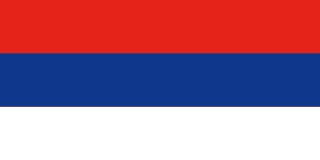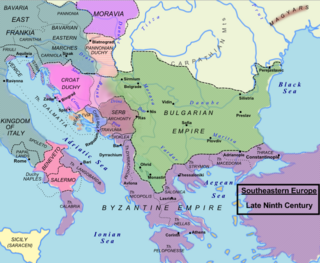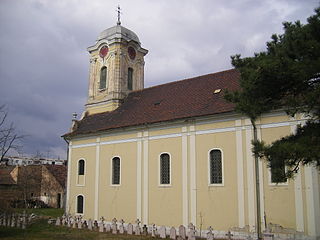Related Research Articles

The State of Slovenes, Croats and Serbs was a political entity that was constituted in October 1918, at the end of World War I, by Slovenes, Croats and Serbs (Prečani) residing in what were the southernmost parts of the Austro-Hungarian Empire. Although internationally unrecognised, this was the first incarnation of a Yugoslav state founded on the Pan-Slavic ideology. Thirty-three days after it was proclaimed, the state joined the Kingdom of Serbia and the Kingdom of Montenegro to form the Kingdom of Serbs, Croats and Slovenes.

János Damjanich was an Austrian military officer who became general of the Hungarian Revolutionary Army in 1848. He is considered a national hero in Hungary.

The Serbs of Croatia or Croatian Serbs constitute the largest national minority in Croatia. The community is predominantly Eastern Orthodox Christian by religion, as opposed to the Croats who are Roman Catholic.
Milan Milišić was a Yugoslav poet, translator, author and journalist from Dubrovnik. He wrote several volumes of poetry and also plays, essays, travel literature, a novel and translated, among others, J. R. R. Tolkien's The Hobbit, the poems of Robert Frost, and Ted Hughes into the Serbo-Croatian language.
The Serb-Catholic movement in Dubrovnik was a cultural and political movement of people from Dubrovnik who, while Catholic, declared themselves Serbs, while Dubrovnik was part of the Habsburg-ruled Kingdom of Dalmatia in the 19th and early 20th centuries. Initially spearheaded by intellectuals who espoused strong pro-Serbian sentiments, there were two prominent incarnations of the movement: an early pan-Slavic phase under Matija Ban and Medo Pucić that corresponded to the Illyrian movement, and a later, more Serbian nationalist group that was active between the 1880s and 1908, including a large number of Dubrovnik intellectuals at the time. The movement, whose adherents are known as Serb-Catholics or Catholic Serbs, largely disappeared with the creation of Yugoslavia.

Kanalites were a medieval Slavic tribe settled in the today's region of Konavle, within Dalmatia, Croatia, mentioned in the chapter titled "Of the Terbounians and Kanalites and of the country they now dwell in" of the 10th century De Administrando Imperio by Byzantine Emperor Constantine VII.
Serbs began migrating to Sweden in large numbers in the 1960s, as part of the migrant work-agreement signed with the Yugoslav government to help Sweden overcome its severe labour shortage. The Yugoslav Wars saw another influx of Serbs.

There is a small number of Serbs in Slovakia, mostly located in the southern town of Komárno, where they have been living since the 17th century. There has also been a historic minority in Bratislava (Požun), where many Habsburg Serbs studied. The number of Slovaks of Serb descent is hard to determine but nevertheless they are recognized as an official minority.

The Serbs in Austria are the second largest ethnic minority group in Austria, after Germans. The first wave of Serbs to Austria began in the early 19th century, while the largest wave was during the migrant worker program of the 1960s and 1970s. Serb immigration to Austria is still active today due to economic and familial factors. Like in most Western European countries, the Serb community in Austria consists mainly of Serbs from Serbia and Bosnia and Herzegovina.
Bosnians are people identified with the country of Bosnia and Herzegovina or with the region of Bosnia. As a common demonym, the term Bosnians refers to all inhabitants/citizens of the country, regardless of any ethnic, cultural or religious affiliation. It can also be used as a designation for anyone who is descended from the region of Bosnia. Also, a Bosnian can be anyone who holds citizenship of the state of Bosnia and Herzegovina and thus is largely synonymous with the all-encompassing national demonym Bosnians and Herzegovinians. This includes, but is not limited to, members of the constituent ethnic groups of Bosnia and Herzegovina: Bosniaks, Serbs, and Croats.

Prečani was a Serbian blanket term used at the end of the 19th- and early 20th century for ethnic Serb communities located preko ("across") the Danube, Sava and Drina rivers, beyond the northern and western borders of 19th-century Serbia, that is, in Austria-Hungary-held Vojvodina, Bosnia and Herzegovina and Croatia. It was thus used to distinguish Serbs of Serbia ("Serbians") from those in the historical Habsburg monarchy; it was not applied to the Serbs of Montenegro or those in the Sanjak of Novi Pazar and elsewhere in the Ottoman Empire.

The Serbs of Vukovar are one of traditional communities living in the multicultural, multi-ethnic and multi-confessional eastern Croatian town of Vukovar on the border with Serbia. The Serb community constitutes slightly over one third of the entire population of Vukovar according to 2011 Census. Other significant communities include the Croat majority, as well as Hungarians, Slovaks, Rusyns, Ukrainians and historically Yugoslavs, Germans, Jews, Vlachs and Turks.

Serb diaspora refers to the diaspora communities of ethnic Serbs. It is not to be confused with the Serbian diaspora, which refers to migrants, regardless of ethnicity, from Serbia. Due to generalization in censuses outside former Yugoslavia to exclude ethnicity, the total number of the Serb diaspora population cannot be known by certainty. It is estimated that 2–3 million Serbs live outside former Yugoslavia.
Sima Lukin Lazić was a Serbian publisher, journalist, historian and writer. Born in Bosanski Brod, Bosnia Vilayet, into a merchant family, his father was involved in anti-Ottoman affairs forcing him to flee to the Principality of Serbia. Lazić was brought up in Šabac, where he finished primary school, then finished three years of gymnasium in Belgrade in 1876. He signed up as a volunteer in the Serbian–Ottoman War (1876–78) but was rejected due to illness. Not finishing gymnasium, he worked as an actor in circuses. From 1886 to 1889 he acted at the Serbian National Theatre in Novi Sad. He lived in Belgrade and Zagreb, where he published texts of all kinds. He was the editor of Srbobran and Vrač pogođač. He was a supporter of the People's Radical Party. He was married to Zorka Miletić, the paternal niece of Svetozar Miletić.

Dejan Jović is a political scientist from Croatia. He is a full-time professor at the Faculty of Political Science at the University of Zagreb. From 2012 to 2020, Jović was editor-in-chief of the Croatian Political Science Review, one of the leading academic journals of political science and social science in Southeast Europe. He is also one of the founders and editor-in-chief of the peer reviewed journal Tragovi: Journal for Serbian and Croatian Topics published by the Serb National Council and the Archive of Serbs in Croatia.

The Civic Platform is a conservative-liberal political organization in Serbia.

Boris Milošević is a Croatian lawyer and politician who served as Deputy Prime Minister of Croatia between 2020 and 2022. He is a member of the Independent Democratic Serb Party (SDSS). He previously served as the president of the Serb National Council from July 2019 until July 2020.
Damjan Daničić is a Serbian professional footballer who plays as a left-back for Prva HNL side Istra 1961, on loan from Dinamo Zagreb.
Anti-Montenegrin sentiment is a generally negative view of Montenegrins as an ethnic group, commonly involving denial of the Montenegrin ethnicity and language, and negative feelings towards Montenegro. It is present in right-wing discourse in Montenegro and the ex-Yugoslavia region, mainly Serbia, and dates back to the 19th and 20th century.
References
- ↑ Miller, Nick (2008). The Nonconformists: Culture, Politics, and Nationalism in a Serbian Intellectual Circle, 1944-1991. Central European University Press. p. 148.
- ↑ Uzelak, Gordona (1998). "Franjo Tudjman's Nationalist Ideology." East European Quarterly. 31.
- ↑ Petrovich, Michael B. (1985). "Review of The National Question in Yugoslavia: Origins, History, Politics." Slavic Review. 4 (2), 369–370
- ↑ "Srbijanac". Hrvatski jezični portal (in Croatian). Znanje d.o.o. and Srce . Retrieved December 31, 2021.
- ↑ "Srbin i Srbijanac". jezicni-savjetnik.hr (in Croatian). Institute of Croatian Language and Linguistics . Retrieved December 31, 2021.
- ↑ Nikola Živković. "Vojvodina? Gde je to?" (in Serbian). Nova srpska politička misao. Archived from the original on 2012-05-20. Retrieved 2012-07-08.
Ovim nije kraj naših podela. Pored reč «dođoši», postoji i pojam «prečani» i «Srbijanci». A kako se zovu Hrvati iz Bosne? Hrvatijanci? Ne, ta reč je naravno moja, veštačka, izmišljena. Ali, zasto[ ta pojava postoji samo kod Srba? Srbi i Srbijanci. Austrougarska je izmislila te podele, a mi Srbi smo ih prihvatili. U tome je problem. Mi prihvatamo jezik neprijatelja. Tuđe olako uzimamo, a odričemo se svoga. Tako smo olako odbacili i ćirilicu.
- ↑ Nikola Tanasić (2012-07-20). "O Srbima, Srbijancima i srbijančenju Srba" (in Serbian). Nova srpska politička misao . Retrieved 2012-07-08.
O upotrebi pojma „Srbijanac“ [...] Međutim, unutar današnjih granica Srbije, „Srbijanci“ se uglavnom koriste na severu, kako bi se (uglavnom pežorativno i prezrivo) denotirali „gedžovani“, primitivci i sirotinja sa juga koja odudara od „zapadnoevropskih“ manira, običaja i „kulture“ tzv. „Vojvođana“. Očigledno je da ova upotreba, međutim, nastaje kasnije i nema veze sa onim „Srbijancima“ o kojima svedoče Vuk Karadžić i Branko Radičević.
- ↑ "Srbin, Srbijanac i Bosanac". B92.
- ↑ V., M. (2013-04-25). "Nigde u Evropi ne postoje "Francužani" ili "Hrvaćani", kao što postoje Srbijanci i Bosanci". Blic.
- ↑ "Јелек, антерија..." (in Serbian). Srpski kod. 2011.
- ↑ Daskalov & Marinov 2013, p. 275, 324.
